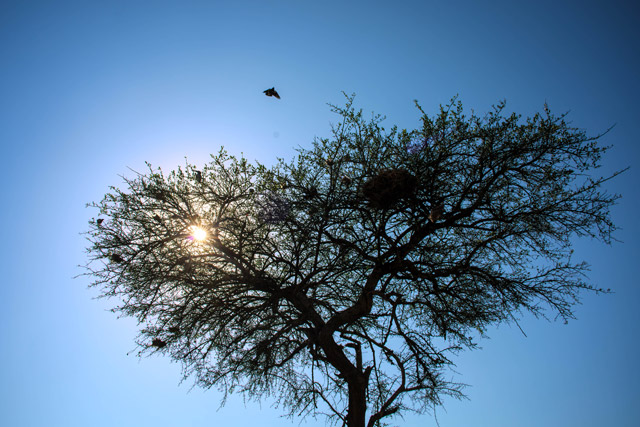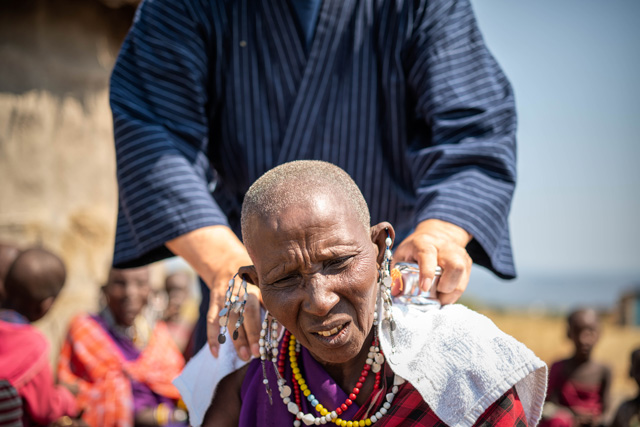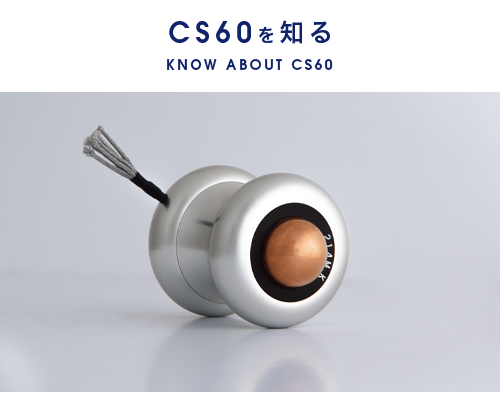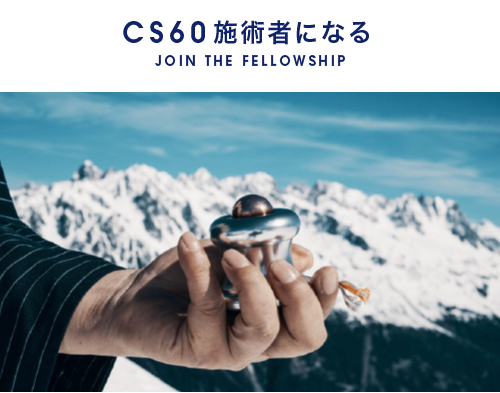
- 2019/08/29
-
Newsletter Vol.21
アフリカ・タンザニアレポート(前編)
Tanzania (Africa) Report Part I
Rapport sur la visite en Tanzanie en Afrique (Première partie) 
先日、アフリカのタンザニアに行ってきました。
赤道に近いから暑いだろうと思って夏服の用意をしたら、朝晩が意外と寒く、
現地でマサイの方々が着ている布を買い、まとっていました。食事はマサイの家庭料理です。
お米を使った料理や、豆類、串にさした鶏肉、バナナなどが目の前に並べられ、スタッフはみんなホッとした顔をしていました。僕も、おいしくて満足!タンザニアでは現地のガイドの方に車に乗せてもらい、マサイの村を回るスケジュール。
サバンナの中に牛やヤギを放牧しながら暮らしている集落がいくつもありました。
家は藁葺きの丸い小屋で、壁は泥を塗った土壁。
マサイの方々は褐色の肌にカラフルな衣装や装飾具をつけていました。
姿勢がいいし、モデルのようにスタイルがいいんです。
「こんなにかっこいい人種はそう見られないだろう」と思いました。
子どもたちも僕らを見るとわーっと寄ってきて、愛嬌があってとても可愛かったです。僕は施術のために、村の女性たちのところに行きました。
女性たちは毎日たくさんの水を運んでいるので、肩や腕がパンパンに張って、「夜ゆっくり眠れないほど痛い」と訴えます。
きれいな腕輪をジャラジャラつけているので、それを外してもらってどんどん施術しました。
一人受けると、「私も、私も」と引っ張りだこ。
みんなとても喜んでいましたよ。次に足を痛めたお年寄りの施術をしました。
隣の家まで歩くのもつらいという彼に、なんとか立ってもらって、そけい部を2〜3分さすりました。
「歩いてください」と言うと、姿勢を伸ばして、サッサッサッと軽やかに歩きます。
彼は僕を見て「名医だ!」とニッコリ。
後で聞いた話では、彼はカメラマンに向かって、マサイの子どもたちと一緒にジャンプして踊っていたそうです。
ここには車椅子も松葉杖もないので、足腰が弱ったら寝たきりになってしまいます。
それは生命を断たれたのと同じようなもの。CS60との出合いにより、彼らもいろいろな意味で希望が見えたのではないでしょうか。
(つづく)
 The other day I visited Tanzania in Africa. I thought that because Tanzania is near the equator that it would be warm. I had packed my summer clothes for the trip, but once I go there found that the mornings and evenings were quite cold, so I bought one of the cloths that the local Masai people wear and wrapped myself up in it.
The other day I visited Tanzania in Africa. I thought that because Tanzania is near the equator that it would be warm. I had packed my summer clothes for the trip, but once I go there found that the mornings and evenings were quite cold, so I bought one of the cloths that the local Masai people wear and wrapped myself up in it.The meals I ate were home cooked Masai dishes. With rice dishes, beans, chicken on skewers, and bananas lined up before us, the staff all looked very relieved. I also thought it was delicious and ate my fill!
In Tanzania, I was scheduled to get driven around some Masai villages by a local guide. There were quite a few villages where people live with herds of cows and goats out grazing on the savannah. The houses were all small, round huts with thatch roofs, and earthen walls painted with mud.
The Masai people had dark skin and wore colorful clothes and jewelry. They all cut excellent figures, and looked as stylish as models. “Has there ever been a nation of people who cut such a fine figure,” I wondered.
When the children saw me, they became excited and ran up to me, with adorable, charming faces.I went to the women’s part of the village to perform treatment. The women of the villages carry water every day. Their arms and shoulders swell up from the strain, and they complain that the pain keeps them up at night.
The women wear beautiful, jangling bracelets, so I had them remove them and began the treatment. Once one of them had experienced the CS60, the others crowded in saying: “me too, me too!”
They all seemed very happy at the effect.Next I treated an older man who had an injured leg. He had trouble even walking as far as the next house. I had him stand up, and treated his groin area for two to three minutes. I told him to walk, and he straightened up, and began to walk briskly and lightly. He looked at me and said, smiling: “you are a master doctor!”
I heard from my cameraman that afterwards he was jumping around, dancing with the Masai children.
The area does not have access to wheelchairs, or even crutches, so people who develop weak legs or lower back problems, they are pretty much immediately bed ridden. Here, that might as well be a life sentence.I hope that encountering the CS60 has given these people some hope in their lives.
(To be continued…)
L’autre jour, je suis allé en Tanzanie en Afrique.
Étant donné que la Tanzanie est située près de l’équateur, j’ai pensé qu’il y ferait chaud alors j’ai amené des vêtements d’été. Pourtant, comme il faisait moins chaud que prévu le matin et le soir, j’ai acheté les vêtements que les Maasaï portent habituellement et je les ai utilisés pendant mon séjour.J’ai mangé tous les jours des plats que les Maasaï cuisinent à la maison : des plats à base de riz, des haricots, des brochettes de poulet, des bananes, etc… Tout le personnel était rassuré. J’ai été également content parce que la cuisine était bonne !
En Tanzanie, un guide sur place nous a amenés en voiture à plusieurs villages Maasaï.
Il y a beaucoup de hameaux dans lesquels les gens vivent en faisant paître des bœufs et des chèvres dans la savane.
Les maisons se caractérisent par un toit de chaume, une forme ronde et des murs en boue.
Les Maasaï, ayant la peau foncée, portent des vêtements et des décorations aux couleurs vives.
Ils se tiennent bien et leur corps ressemble à ceux des mannequins.
J’ai pensé qu’il serait difficile de rencontrer de nouveau un peuple si beau.
Dès que les enfants nous ont trouvés, ils sont venus vers nous en hâte. Ils étaient adorables et très mignons.Je suis allé chez les femmes des villages pour les soigner.
Étant donné qu’elles transportent tous les jours beaucoup d’eau, elles ont des courbatures aux épaules et aux bras. Elles ont dit qu’elles n’arrivaient pas à dormir tranquillement pendant la nuit parce qu’elles avaient mal.
Je leur ai demandé d’enlever les jolis bracelets qu’elles portent souvent puis je les ai bien soignées.
Dès qu’une thérapie se terminait, les autres femmes me demandaient de nouveau de continuer mes soins.
Tout le monde était très content.Ensuite, j’ai soigné une personne âgée ayant mal à la jambe.
Il avait tellement mal qu’il avait du mal à marcher jusqu’à la maison d’à côté. Mais j’ai osé lui demander de se mettre debout et j’ai frotté son articulation entre bassin et la jambe pendant 2 ou 3 minutes.
Je lui ai ensuite demandé de marcher. Il s’est alors étiré et a commencé à marcher d’une façon légère.
Il m’a regardé avec un grand sourire en disant que j’était un bon médecin.
Selon une histoire que j’ai étendue plus tard, après notre départ, il a dansé en sautant avec les enfants Maasaï devant un photographe.
Ici, il n’y a pas de fauteuil roulant ni de béquille, alors si on a les membres faibles, on ne quitte plus son lit.
C’est comme si on perd sa vie.Je pense que grâce à la rencontre avec le CS60, ils arrivent maintenant à regagner espoir.
(à suivre)
INDEX
















